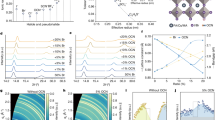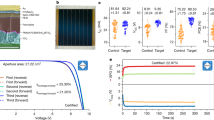Abstract
Formamidinium–caesium mixed-cation perovskites have shown better thermal stability than their methylammonium-containing counterparts but they suffer from photoinstability induced by iodide migration and phase segregation. Here we improve their photostability by adding slightly excessive AX (at a molar percentage of 0.25% to Pb2+ ions), where A is formamidinium or caesium and X is iodine. The excessive AX does not improve the initial solar cell efficiency. It compensates iodide vacancies and suppresses ion migration and defects generation during long-term illumination by around tenfold compared with AX-deficient devices. Consequently, generation of hole traps and phase segregation is impeded, with the former limiting solar cell efficiency after degradation. The perovskite mini-modules reached a certified stabilized efficiency of 18.6% with an aperture area of ~30 cm2, corresponding to an active area efficiency of 20.2%. The mini-module maintains 93.6% of the initial efficiency after continuous operation under 1 sun illumination for >1,000 h at 50 ± 5 °C in air.
This is a preview of subscription content, access via your institution
Access options
Access Nature and 54 other Nature Portfolio journals
Get Nature+, our best-value online-access subscription
$29.99 / 30 days
cancel any time
Subscribe to this journal
Receive 12 digital issues and online access to articles
$119.00 per year
only $9.92 per issue
Buy this article
- Purchase on Springer Link
- Instant access to full article PDF
Prices may be subject to local taxes which are calculated during checkout




Similar content being viewed by others
Data availability
All data generated or analysed during this study are included in the article and its Supplementary Information. Source data are provided with this paper.
References
Best Research‐Cell Efficiency Chart (NREL, 2020); https://www.nrel.gov/pv/cell-efficiency.html
Rong, Y. et al. Challenges for commercializing perovskite solar cells. Science 361, eaat8235 (2018).
Bai, S. et al. Planar perovskite solar cells with long-term stability using ionic liquid additives. Nature 571, 245–250 (2019).
Turren-Cruz, S.-H., Hagfeldt, A. & Saliba, M. Methylammonium-free, high-performance, and stable perovskite solar cells on a planar architecture. Science 362, 449–453 (2018).
Wang, L. et al. A Eu3+–Eu2+ ion redox shuttle imparts operational durability to Pb–I perovskite solar cells. Science 363, 265–270 (2019).
Wang, Y. et al. Stabilizing heterostructures of soft perovskite semiconductors. Science 365, 687–691 (2019).
Bi, E. et al. Efficient perovskite solar cell modules with high stability enabled by iodide diffusion barriers. Joule 3, 2748–2760 (2019).
Liu, Z. et al. A holistic approach to interface stabilization for efficient perovskite solar modules with over 2,000-hour operational stability. Nat. Energy 5, 596–604 (2020).
Eperon, G. E. et al. Formamidinium lead trihalide: a broadly tunable perovskite for efficient planar heterojunction solar cells. Energy Environ. Sci. 7, 982–988 (2014).
Tan, S. et al. Shallow iodine defects accelerate the degradation of α-phase formamidinium perovskite. Joule 4, 2426–2442 (2020).
Li, N. et al. Microscopic degradation in formamidinium–cesium lead iodide perovskite solar cells under operational stressors. Joule 4, 1743–1758 (2020).
Slotcavage, D. J., Karunadasa, H. I. & McGehee, M. D. Light-induced phase segregation in halide-perovskite absorbers. ACS Energy Lett. 1, 1199–1205 (2016).
Brivio, F., Caetano, C. & Walsh, A. Thermodynamic origin of photoinstability in the CH3NH3Pb (I1–xBrx)3 hybrid halide perovskite alloy. J. Phys. Chem. Lett. 7, 1083–1087 (2016).
Li, Z. et al. Stabilizing perovskite structures by tuning tolerance factor: formation of formamidinium and cesium lead iodide solid-state alloys. Chem. Mater. 28, 284–292 (2016).
Lee, J. W. et al. Formamidinium and cesium hybridization for photo‐and moisture‐stable perovskite solar cell. Adv. Energy Mater. 5, 1501310 (2015).
Charles, B. et al. Phase behavior and substitution limit of mixed cesium–formamidinium lead triiodide perovskites. Chem. Mater. 32, 2282–2291 (2020).
Deng, Y. et al. Tailoring solvent coordination for high-speed, room-temperature blading of perovskite photovoltaic films. Sci. Adv. 5, eaax7537 (2019).
Deng, Y. et al. Reduced self-doping of perovskites induced by short annealing for efficient solar modules. Joule 4, 1949–1960 (2020).
Chen, B. et al. Grain engineering for perovskite/silicon monolithic tandem solar cells with efficiency of 25.4%. Joule 3, 177–190 (2019).
Lee, J.-W. et al. 2D Perovskite stabilized phase-pure formamidinium perovskite solar cells. Nat. Commun. 9, 3021 (2018).
Jiang, Q. et al. Surface passivation of perovskite film for efficient solar cells. Nat. Photon. 13, 460–466 (2019).
Zheng, X. et al. Managing grains and interfaces via ligand anchoring enables 22.3%-efficiency inverted perovskite solar cells. Nat. Energy 5, 131–140 (2020).
Lee, M. M., Teuscher, J., Miyasaka, T., Murakami, T. N. & Snaith, H. J. Efficient hybrid solar cells based on meso-superstructured organometal halide perovskites. Science 338, 643–647 (2012).
Jahandar, M. et al. High-performance CH3NH3PbI3-inverted planar perovskite solar cells with fill factor over 83% via excess organic/inorganic halide. ACS Appl. Mater. Interfaces 9, 35871–35879 (2017).
Son, D.-Y. et al. Self-formed grain boundary healing layer for highly efficient CH3NH3PbI3 perovskite solar cells. Nat. Energy 1, 1–8 (2016).
Chen, B. et al. Synergistic effect of elevated device temperature and excess charge carriers on the rapid light‐induced degradation of perovskite solar cells. Adv. Mater. 31, 1902413 (2019).
Domanski, K., Alharbi, E. A., Hagfeldt, A., Grätzel, M. & Tress, W. Systematic investigation of the impact of operation conditions on the degradation behaviour of perovskite solar cells. Nat. Energy 3, 61–67 (2018).
Tumen‐Ulzii, G. et al. Detrimental effect of unreacted PbI2 on the long‐term stability of perovskite solar cells. Adv. Mater. 32, 1905035 (2020).
Roose, B., Dey, K., Chiang, Y.-H., Friend, R. H. & Stranks, S. D. A critical assessment of the use of excess lead iodide in lead halide perovskite solar cells. J. Phys. Chem. Lett. 11, 6505–6512 (2020).
De Wolf, S. et al. Organometallic halide perovskites: sharp optical absorption edge and its relation to photovoltaic performance. J. Phys. Chem. Lett. 5, 1035–1039 (2014).
Fu, F. et al. I2 vapor-induced degradation of formamidinium lead iodide based perovskite solar cells under heat–light soaking conditions. Energy Environ. Sci. 12, 3074–3088 (2019).
Tao, S. et al. Absolute energy level positions in tin-and lead-based halide perovskites. Nat. Commun. 10, 2560 (2019).
Game, O. S., Buchsbaum, G. J., Zhou, Y., Padture, N. P. & Kingon, A. I. Ions matter: description of the anomalous electronic behavior in methylammonium lead halide perovskite devices. Adv. Funct. Mater. 27, 1606584 (2017).
Domanski, K. et al. Migration of cations induces reversible performance losses over day/night cycling in perovskite solar cells. Energy Environ. Sci. 10, 604–613 (2017).
Lin, Y. et al. Excess charge-carrier induced instability of hybrid perovskites. Nat. Commun. 9, 4981 (2018).
Draguta, S. et al. Rationalizing the light-induced phase separation of mixed halide organic–inorganic perovskites. Nat. Commun. 8, 200 (2017).
Motti, S. G. et al. Controlling competing photochemical reactions stabilizes perovskite solar cells. Nat. Photon. 13, 532–539 (2019).
Ni, Z. et al. Revealing the Chemical Nature of Defects in Metal Halide Perovskites (2020).
Eames, C. et al. Ionic transport in hybrid lead iodide perovskite solar cells. Nat. Commun. 6, 7497 (2015).
Motti, S. G. et al. Defect activity in lead halide perovskites. Adv. Mater. 31, 1901183 (2019).
Du, M.-H. Density functional calculations of native defects in CH3NH3PbI3: effects of spin–orbit coupling and self-interaction error. J. Phys. Chem. Lett. 6, 1461–1466 (2015).
Di Girolamo, D. et al. Ion migration‐induced amorphization and phase segregation as a degradation mechanism in planar perovskite solar cells. Adv. Energy Mater. 10, 2000310 (2020).
Almora, O. et al. Capacitive dark currents, hysteresis, and electrode polarization in lead halide perovskite solar cells. J. Phys. Chem. Lett. 6, 1645–1652 (2015).
Bertoluzzi, L. et al. Mobile ion concentration measurement and open-access band diagram simulation platform for halide perovskite solar cells. Joule 4, 109–127 (2020).
Kim, G. Y. et al. Large tunable photoeffect on ion conduction in halide perovskites and implications for photodecomposition. Nat. Mater. 17, 445–449 (2018).
Albertus, P., Babinec, S., Litzelman, S. & Newman, A. Status and challenges in enabling the lithium metal electrode for high-energy and low-cost rechargeable batteries. Nat. Energy 3, 16–21 (2018).
Wang, H., Jang, Y. I., Huang, B., Sadoway, D. R. & Chiang, Y. M. TEM study of electrochemical cycling‐induced damage and disorder in LiCoO2 cathodes for rechargeable lithium batteries. J. Electrochem. Soc. 146, 473 (1999).
Green, M. et al. Solar cell efficiency tables (version 57). Prog. Photovolt. 29, 3–15 (2020).
Hong, Z., Huang, Z. & Zeng, X. Utilization of copper phthalocyanine and bathocuproine as an electron transport layer in photovoltaic cells with copper phthalocyanine/buckminsterfullerene heterojunctions: thickness effects on photovoltaic performances. Thin Solid Films 515, 3019–3023 (2007).
Prasanna, R. et al. Design of low bandgap tin–lead halide perovskite solar cells to achieve thermal, atmospheric and operational stability. Nat. Energy 4, 939–947 (2019).
Xiao, Z. et al. Unraveling the hidden function of a stabilizer in a precursor in improving hybrid perovskite film morphology for high efficiency solar cells. Energy Environ. Sci. 9, 867–872 (2016).
Acknowledgements
This work was supported by University of North Carolina at Chapel Hill. Part of the material is based on work supported by the Office of Naval Research under contract no. N68335-20-C-0390 through a subcontract from Perotech Inc. This work was performed, in part, at the Chapel Hill Analytical and Nanofabrication Laboratory (CHANL), a member of the North Carolina Research Triangle Nanotechnology Network (RTNN), which is supported by the National Science Foundation (grant ECCS-1542015), as part of the National Nanotechnology Coordinated Infrastructure (NNCI).
Author information
Authors and Affiliations
Contributions
J.H. and Y.D. conceived the idea. Y.D. designed the experiments, conducted most of the device fabrication and measurement, and prepared the modules for certification. Y.D. and S.X. conducted the photoluminescence studies. S.C. captured the SEM images. X.X. and J.Z. performed the XRD measurements. Y.D. and J.H. wrote the paper, and all authors reviewed the paper.
Corresponding author
Ethics declarations
Competing interests
J.H. and Y.D. are inventors on a patent application related to this work filed by University of North Carolina Chapel Hill (US 63/060,451, filed 03 August 2020). J.H. has disclosed a significant financial interest in Perotech Inc. The other authors declare no competing interests.
Additional information
Peer review information Nature Energy thanks Jin-Wook Lee, Nam-Gyu Park and the other, anonymous, reviewer(s) for their contribution to the peer review of this work.
Publisher’s note Springer Nature remains neutral with regard to jurisdictional claims in published maps and institutional affiliations.
Supplementary information
Supplementary Information
Supplementary Figs. 1–25.
Supplementary Data 1
Source data for statistics in Supplementary Figs. 4, 6, 7, 8, 10, 16, 19.
Source data
Source Data Fig. 2
Source data for statistics plot9.
Source Data Fig. 3
Source data for statistics plot9.
Source Data Fig. 4
Source data for statistics plot9.
Rights and permissions
About this article
Cite this article
Deng, Y., Xu, S., Chen, S. et al. Defect compensation in formamidinium–caesium perovskites for highly efficient solar mini-modules with improved photostability. Nat Energy 6, 633–641 (2021). https://doi.org/10.1038/s41560-021-00831-8
Received:
Accepted:
Published:
Issue Date:
DOI: https://doi.org/10.1038/s41560-021-00831-8
This article is cited by
-
Multifunctional entinostat enhances the mechanical robustness and efficiency of flexible perovskite solar cells and minimodules
Nature Photonics (2024)
-
Triple-junction solar cells with cyanate in ultrawide-bandgap perovskites
Nature (2024)
-
Bridging buried interface enable 24.67%-efficiency doctor-bladed perovskite solar cells in ambient condition
Nano Research (2024)
-
Ion-induced field screening as a dominant factor in perovskite solar cell operational stability
Nature Energy (2024)
-
The first demonstration of entirely roll-to-roll fabricated perovskite solar cell modules under ambient room conditions
Nature Communications (2024)



